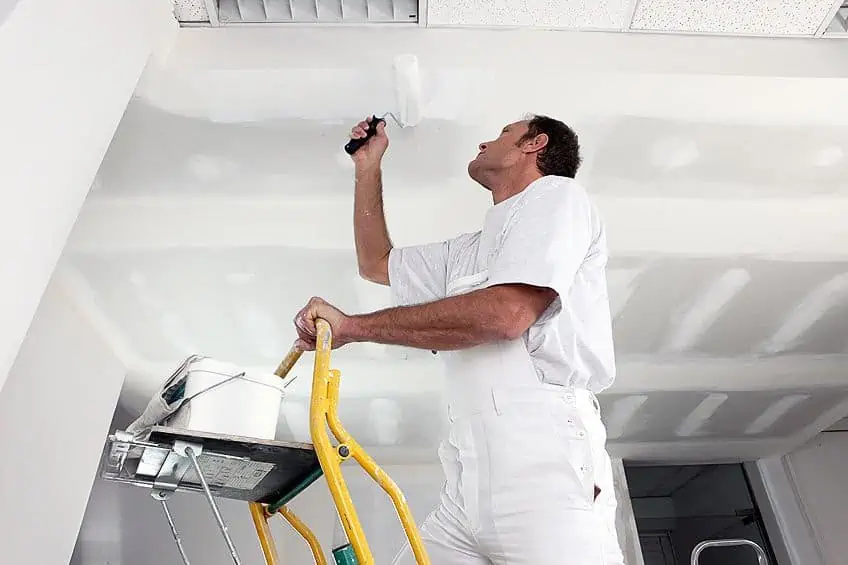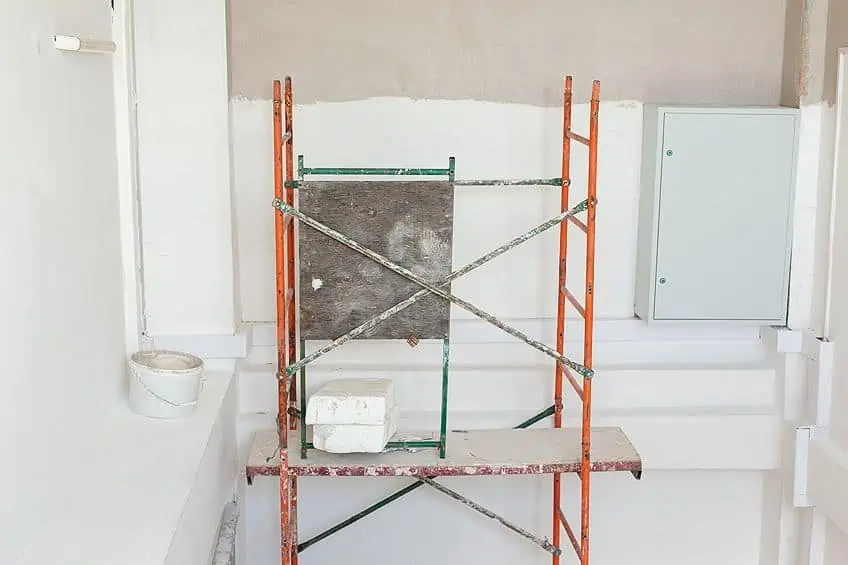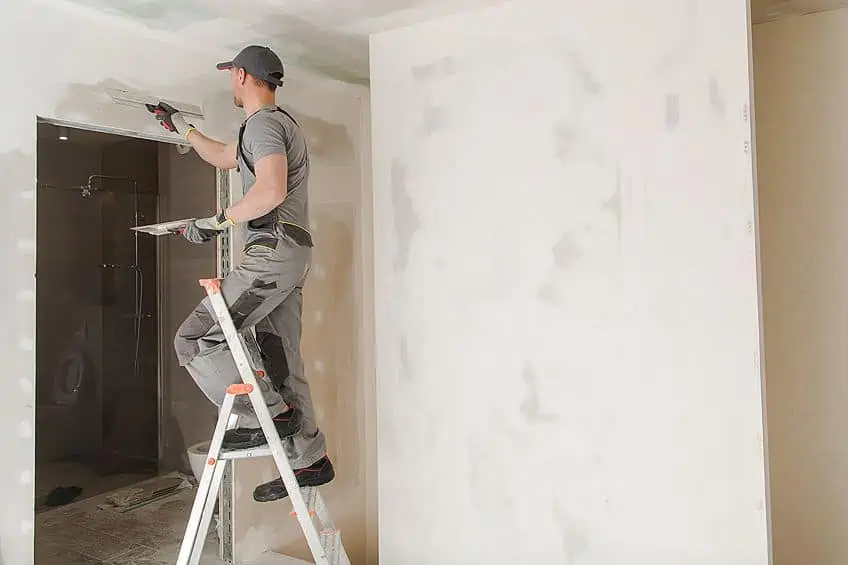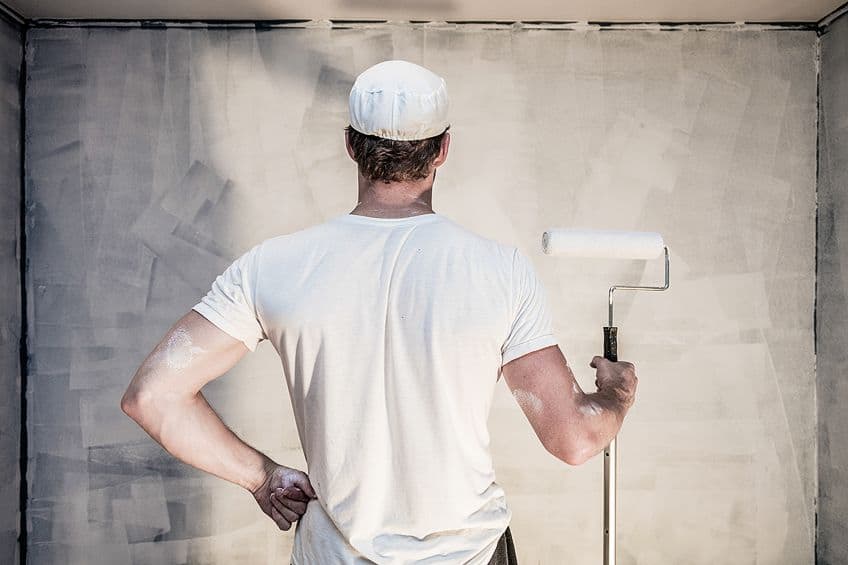Best Drywall Primer – Complete Guide on How to Prime Drywall
This post may contain affiliate links. We may earn a small commission from purchases made through them, at no additional cost to you.
Drywall is often used to build ceilings and walls during construction or renovations. When the drywall has been installed properly, which means mudding and taping have been done, it will be necessary to apply several layers of paint to work well with your color scheme and décor. First, the drywall will have to be coated with a primer, so that your paint does not just soak into it. This article will go into more detail about drywall primers and give you a better understanding of how to prime drywall.
Table of Contents
- 1 What is Drywall Primer?
- 2 Purchasing a Drywall Primer
- 3 Best Drywall Primer Products
- 3.1 Best Choice for an Overall Drywall Primer: KILZ Adhesion High-Bonding Primer/Sealer
- 3.2 Best Product for an All-Purpose Drywall Primer: RUST-OLEUM Zinsser Bull’s Eye 1-2-3 Primer
- 3.3 Best Available Option for Stain-Blocking Drywall Primer: KILZ Restoration Maximum Stain and Odor Blocking Interior Primer
- 3.4 Best Product Available for Use as a PVA Drywall Primer: VALSPAR Interior PVA Wall Primer
- 4 How to Apply Drywall Primer
- 5 Tips on How to Use Drywall Primers
- 6 Frequently Asked Questions
What is Drywall Primer?
Primer is necessary to ensure you have an even surface for painting onto your new drywall. Most consider the best drywall primer to be Polyvinyl Acetate (PVA) primer. This primer is made up of the same ingredients that you would find in wood glue. This kind of primer is perfect to be used as a drywall sealer as it performs well on porous surfaces and assists in covering up and nail heads or seams. The primer ensures the surface is even and ready to be painted on. This drywall primer has been formulated to adhere better to the surface than paint adheres.
If you thought you could just apply several coats of paint and that would be sufficient, then think again. Firstly, a lot of paint will go to waste. Secondly, the final layer of paint will be uneven, and your selected sheen will look different over non-taped and taped areas. This will probably occur with each layer you apply, and the results will not last long.

To stop the paint from being absorbed all primer for new drywall will be required. The primer seals the drywall. This will decrease the growth of mold in rooms like the kitchen or the bathroom where there is excessive moisture.
Types of Drywall Primer
You can prepare your drywall surface, quickly, effectively, and with minimal costs, by applying drywall primer. First, you will need to prepare your drywall. As previously mentioned, one option is to use a PVA drywall primer. This is thanks to it being well-priced and formulated specifically to act as a sealer on drywall.
You can also purchase a primer-and-paint option, which also contains thickening agents. These are referred to as self-priming paints. These products contain PVA and the consistency is much thicker than standard paint, which means it is not necessary to apply many layers. With only two coats you should be able to achieve an even surface.

- Primer-Sealer: this is a product that has been formulated to specifically prime and seal drywall.
- High-Build Primer: this primer offers great coverage to your drywall, while also filling in any cracks. You will achieve a great undercoat by applying a thick coat and it will offer a level finish.
- Tinted Primer: by adding paint to a high-build primer you can create your tinted primer. The layer will not be the same color as your top layer but will be as close to a match as possible. This means you will only require one layer to achieve an even finish.
- Bonding Primer: this primer offers a very strong bond on both smooth and porous surfaces. You will receive a strong bond and thick coat when applying this primer.
- Acrylic Primer: this is a pricey option, but the expense is worth it. The primer can seal and cover up any cracks and will offer you a smooth, even coat.
- BIN Primer: this primer is shellac-based and dries very fast. The primer is a great stain killer and can be used as a sealer. Your primer must be completely dry before you can begin painting over it.
- Alkyd Primer: this primer is oil-based and dries very fast. If you have any water stains, this is the ideal primer to use.
- Skim Coat: this is a joint drywall compound which you would use a drywall knife to apply. This primer offers you a smooth and flat surface that can then be painted on.
The best choice of primer for new drywall is the primer-sealer option. This primer will not just seal the surface, it will also cover any imperfections or variations, ensuring you have an even surface to paint on.
Table of Drywall Primers
We have put together a table containing the types of drywall primer and each one’s main purpose. If you decide to not use drywall primer sadly the paint you apply will begin to peel and the top coat of paint will not adhere correctly. You will likely end up with an uneven finish, making it very difficult to clean the wall. So, at the end of the day, it is best to take the time and prepare and prime your drywall surfaces correctly to achieve a long-lasting and even finish.
| Types of Primer | Primer’s Purpose |
| Drywall Sealer/Primer | Specially created for drywalls, available in both oil- and water-based options |
| High-Build Primer | Offers amazing coverage |
| Tinted Primer | Offers a base color that is similar to your topcoat of paint’s color, providing a better finish |
| Bonding Primer | Offers an extreme bond to difficult surfaces |
| BIN Primer | A fast-drying primer that is shellac-based. Great stain killer and sealer |
| Skim Primer | Drywall point compound that offers a smooth, even finish |

Pros and Cons of Drywall Primer
We will be focusing on the drywall sealers and primers which are more commonly used. You have two options to choose from, being a water-based or oil-based product. It is possible to tint a drywall primer so that it can match the paint you have selected to use. Certain paint stores may even offer the service to tint your primer at an added cost.
- Certain primers can assist in preventing or blocking stains and resist things such as mildew
- Can be sanded with ease
- Water-based primers are easier to clean and have less volatile organic compounds (VOCs)
- Fewer coats are required, this means less paint is used
- Creates a uniform base color onto which you can apply the topcoat
- Oil-based primers contain high levels of VOC and often have a stronger odor
Purchasing a Drywall Primer
If you know what you need, it is really easy to purchase a drywall primer. So, what should you be looking for? It can all seem a little overwhelming as there are so many different options to choose from. We have put together a list of aspects you should take into consideration when selecting a drywall primer.
Understanding the Purpose
You need to have a clear understanding of what you require the drywall primer to do, to select the correct product. The question you need to ask is, what purpose does the product serve, and is it required? Your requirements might mean that you need to purchase a top-end specialized primer.
Moisture and Stain Resistance
Certain primers offer resistance to moisture and stains – you do not want your work to be ruined because you did not consider this feature. If you are working in a room such as a kitchen or a bathroom, where there is a lot of moisture, you will require moisture resistance.

Scent
Water-based primers give off hardly any odor in comparison to oil-based primers. That said you will always need to consult the label, as you can find oil-based primer-sealers which give off no odor and can be used both outdoors and indoors.
The Condition of the Wall
If the wall is very uneven, or has a lot of holes, or may have nails sticking out of it, you will need to look at purchasing a high-build drywall primer. This type of primer covers most flaws thanks to it being much thicker. It offers a more even surface ideal for the application of paint. However, if you have perfectly smooth drywall, you could then use a standard primer. Regardless, it is best to use a good-quality drywall primer.

Coverage
How big is there an area you will need to cover? Once you have answered this question, you will then have an idea of the volume of primer you will require. We suggest you purchase more primer than you think you will need. You should also look at the size of the product you are buying, as the primer is available in different quantities, from quart- to gallon-sized containers.
Primer Cost
If you are working with a budget you might think of purchasing a cheaper primer. Sadly, these products might be of poor quality or unreliable. Rather select a more well-known brand that has received positive reviews. You can save money and time by going with an affordable option.
All-Purpose Primer vs. Specialized Primer
Certain primers have been designed to work on the majority of surfaces, while others can only be used on certain types of surfaces. Consider buying the all-purpose option, as you want to have any go to waste, as leftovers can be used on other projects.

Best Drywall Primer Products
To assist you in selecting the right product for you we have put together details of a few of the best drywall primers available. Have a look at the list of options we have put together, and determine which one suits your needs the best. All of the options we have listed are available online, though most of them will be available at your local paint or hardware store.
Best Choice for an Overall Drywall Primer: KILZ Adhesion High-Bonding Primer/Sealer
This is considered a heavy-duty primer that provides amazing adhesives properties, particularly when used on difficult surfaces. The primer takes about half an hour to dry completely. Thanks to the primer you will not experience any problems with peeling or cracks, and it will last for a long time. This means that your wall will not show signs of deterioration. Before applying it, no sanding is necessary. This is thanks to the primer ensuring a smooth surface and perfect coverage. Despite the primer not being a stain blocker, it does offer you great stain blocking properties.
- A high adhesion primer to increase painting possibilities
- Suitable for most interior and exterior surfaces
- Dries to touch within 30 minutes
- No odor
- Does not require sanding
- Dries quickly
- Provides amazing adhesives properties
- Expensive
- You will have to wear safety gear when working with the product, due to the high levels of VOCs
Best Product for an All-Purpose Drywall Primer: RUST-OLEUM Zinsser Bull’s Eye 1-2-3 Primer
This is a popular choice of primer thanks to it being easy to clean and water-based. You can use this primer both outdoors and indoors and it will adhere to the majority of surface materials very well. You will not have to sand it, and it assists in resistance to blistering, peeling, and mildew. However, should your surface have stains, you will not be able to cover them up with this primer. Unfortunately, the stains will bleed through.
- A water-based interior and exterior primer
- Contains a rust inhibitor for metal surfaces
- Sticks to most surfaces without requiring sanding
- Simple to use
- Easy to clean and water-based
- Resistant to peeling and mildew
- Sanding is not required
- It will work on most surfaces
- It Will not work as a stain blocker
- To ensure the best coverage, might require several coats
Best Available Option for Stain-Blocking Drywall Primer: KILZ Restoration Maximum Stain and Odor Blocking Interior Primer
This is a water-based sealer and primer which has been formulated to function the same as an oil-based primer. You will be able to cover tough stains caused by water damage or grease when using this primer. This primer will also cover up strong odors. The primer offers superb adhesion properties and can be used on several different surfaces, such as brick, drywall, wood, plaster, glass, and more.
- Water-based primer, sealer and stain blocker, performs like an oil-based product
- You can apply this primer with a brush, roller or airless sprayer
- It seals strong odors (fire, smoke, pets), dries hard and sands easily
- Can be sanded with ease
- Amazing odor and stain blocker
- Only takes 30 minutes to dry
- Amazing adhesion
- Pricey
- Might not block certain strong odors
Best Product Available for Use as a PVA Drywall Primer: VALSPAR Interior PVA Wall Primer
This primer will provide a seal for drywall as well as unpainted plaster, creating a smooth surface. The PVA drywall primer can be used with either latex or oil-based paint and can be applied to both glossy and porous surfaces. The primer can be applied to the majority of surfaces and has a thick consistency that will cover most stains.
- Effectively seals porous surfaces, preparing them for any topcoat
- It can be used on bare or previously painted drywall, plaster, wood, and masonry
- This PVA primer can be brushed, rolled, and sprayed
- Well priced
- Cleans up with ease and is water-based
- No sanding is needed to seal glossy surfaces
- Easy to sand down and create a smooth and even surface
- VOC levels are low
- Thick enough consistency that can cover most stains and surfaces
- Not widely available
- Can be hard to handle because of its thick consistency
How to Apply Drywall Primer
When it is time to apply a primer for new drywall, it is not necessary to purchase the most expensive option. New walls are normally pristine, with no cracks or holes, or stains and odors. On the other hand, if you are working on existing walls when renovating and the walls are damaged or have stains, it will be necessary to apply a drywall primer. Ideally, you want to use a drywall primer that has stain-blocker features.
Either way, there are some basic steps you need to follow when painting your drywall surface.
The first thing you will have to do is inspect the drywall. Look over the drywall surface carefully and make note of any cracks or holes. You will need to use drywall mud to fill these, and you will then have to use a pole sander to sand the wall to ensure you have a smooth and even surface.
When you have finished sanding ensure that any dust is cleaned away. Vacuum the dust and then using a clean, dry cloth, gently wipe down the walls. Alternatively, you can use a product called Swiffer Sweeper instead. You will be able to use a sweeper for other purposes throughout the home.
Now it’s time to deal with how to prime drywall. Certain people suggest using flat paint as the primer; however, if you choose to do this you will not achieve a long-lasting and smooth finish. You can use a product that is a combined paint and primer but only uses this option if the wall is in pristine condition or new. If you are unsure, rather use a high-quality drywall primer and sealer, as it has been created specifically for this purpose.

Cover the whole wall in primer. You can paint the primer using a brush, which will be able to manage the corners and precision work. To cover the larger area, you can start using a paint roller.
Another option is to spray the primer on, but rather call in the professionals to do this when working with drywall.
It will take between three hours, or as quick as 30 minutes, for the primer to dry. Make sure that you consult the product label for the drying time, as the type of primer and even the humidity can impact the drying time. When the initial coat has dried, you can apply the second coat. Once this coat has also dried you will be able to apply the topcoat.
Tips on How to Use Drywall Primers
You have finished taping and mudding as well as sanding down your drywall surface. The following step is to create a stunning finish to your drywall surfaces. We have put together a few tips and tricks to assist you in achieving this by applying the best drywall primer:
- Preparation is imperative. You will need to fill any imperfections or holes to ensure your surface is as smooth as possible.
- When removing the dust after sanding, do not use a wet cloth. This can negatively impact the mud.
- We recommend using a lint-free paint roller and to ensure all the tools you use are of top quality.
- When you have primed the surface, try to paint the walls within 48 hours.
- You can use a sanding pole with 220-grit paper to sand down your drywall.
- If you are painting over color, we recommend using a tinted primer.
- Ensure the lighting where you are working is good, so you can check your work as you go.
- Cover nearby floors and furniture with a drop cloth.
- To assist with ventilation, you can place a few fans around the room. All windows should be opened when you are working to assist with the ventilation.

Frequently Asked Questions
Are There any Differences Between Drywall Primer and Primer?
A top-quality drywall primer has been specifically formulated to act as a drywall primer and sealer by sealing the porous surface and offering a surface for the paint to adhere to. On the other hand, a standard primer will only offer you a surface that paint can adhere to.
What is Drywall?
Drywall is a product that is used for ceilings, construction of walls, etc. Drywall is made from gypsum plaster with additional additives like cellulose, mica, paper, and clay. It is an easy and fast option to install and can be painted to match your chosen colors. Drywall can be repaired if necessary and is particularly durable.
Do You Need to Apply Drywall Primer Before Painting?
Rather don’t, as the paint requires a better surface to adhere to. Without a primer, the porous drywall surface would absorb all the paint. You also require a primer to stop paint from cracking and peeling off once dry. The use of a primer will also ensure all joint compounds and unevenness is covered up and will offer you a smooth and even surface to paint on.
When Working With a Wooden Surface Can You Apply Drywall Primer?
Please do not do this! Drywall and wood are very different materials, and you will require different types of primer for each.
How Quickly Does Drywall Primer Dry?
It takes roughly 30 minutes for drywall primer to dry, but it can potentially take anywhere between a couple of hours to a full day to dry. The drying time is impacted by humidity, the surrounding temperature, and what type of primer you are using. To get accurate instructions you will need to consult the product information.
Drywall primer will create an even and smooth finished surface for you to apply paint to. If you have used the best drywall primer for your walls you will create the perfect surface for the paint to adhere to. We hope the above article will assist you in understanding the importance of drywall primer, while also ensuring you select the best drywall primer for your project.












